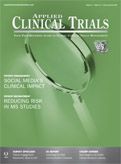FDA Strives to Maintain Gains in Speeding More Breakthroughs to Patients
Applied Clinical Trials
Now the challenge to FDA and to sponsors is to maintain the high level of support for research, discovery, and regulatory flexibility underpinning these gains, writes Jill Wechsler.
New drug approvals reached record levels last year, with FDA approving 46 new molecular entities (NMEs), more than double the number in 2016. Add to that the landmark gene and CAR-T cellular therapies and vaccines regulated as biologics. This achievement reflects a large number of applications filed with the agency for breakthrough cancer and rare diseases treatments that qualify for more streamlined clinical testing and accelerated review. Now the challenge to FDA and to sponsors is to maintain the high level of support for research, discovery, and regulatory flexibility underpinning these gains.
Jill Wechsler

Whether approval numbers remain high in 2018 involves a range of factors. Several late 2017 decisions were scheduled for review this year, a process that often reduces review numbers in subsequent months: FDA approved 45 novel drugs in 2015, but only 22 in 2016. At the same time, the R&D pipeline is full: the Center for Drug Evaluation and Research (CDER) reported an increase in submissions last year and that it is overseeing more than 7,000 active investigational new drug applications (INDs) for drugs and biologics.
The ability of FDA and sponsors to expeditiously move important therapies through development and review reflects innovations in clinical research strategies and in regulatory policy. FDA is approving more critical treatments for life-threatening conditions based on results from small and early clinical studies. While some critics claim that such truncated clinical research puts patients at risk, FDA officials insist that it is maintaining high standards while paying more attention to risk-benefit assessments that reflect patient needs and preferences.
Maintaining momentum
Further modernization of FDA medical product oversight remains a key goal for Commissioner Scott Gottlieb, who has rolled out multiple initiatives in recent months to better inform R&D policies. Many of these implement provisions of the 21st Century Cures Act that authorize more efficient clinical research strategies and more collaboration within FDA in reviewing innovative and challenging therapies. FDA launched the Oncology Center for Excellence last year, which was instrumental in approving new breakthrough gene therapies, and Gottlieb is considering additional cross-agency Centers to facilitate development of immunology and neuroscience treatments. Similarly, the Center for Biologics Evaluation and Research (CBER) established a framework for evaluating Regenerative Medicine Advanced Therapies (RMATs), issuing guidances and developing standards and definitions to help sponsors utilize the program.
FDA also is advancing programs to qualify drug development tools such as biomarkers, animal models, and clinical outcome assessments (COAs); a scale for assessing patient reported outcomes related to major depressive disorders is under review. And the development of new antibacterial medicines should gain from the Limited Population Pathway (LPAD) for testing treatments for infections in small patient populations. The Cures Act further encourages use of novel clinical trial designs, modeling and simulations for evidence of effectiveness, as well as for optimizing dosing and evaluating adverse events. And it supports broader incorporation of complex adaptive studies into clinical protocols, a topic that will be discussed at an FDA public meeting in March 2018.
New guidance published in December aims to further encourage development of targeted medicines that address underlying genetic mutations. The advisory supports enrollment of patients with rare mutations in clinical trials for promising therapies, including those that target a molecular subtype common across different phenotypes, such as Merck’s Keytruda (pembrolizumab). A second guidance discusses the assessment and use of in vitro diagnostic (IVD) devices in clinical trials to determine if the IVD requires separate FDA review. The aim is to prevent clinical study failure due to uncertainties about biomarker validity. Further guidance will assess the risks related to certain IVDs used in oncology studies, with the goal of simplifying the development of companion diagnostics and their use in drug development.
FDA ended the year with additional advisories on how sponsors should best utilize a range of formal meetings and other means of communicating with agency staffers during drug development, with the goal of further improving the speed and efficiency of the drug approval process.
While it will be difficult for FDA to achieve another year of record approvals, the pace of policy development and regulatory innovation shows every sign of continuing at a fast pace. In recognition of the globalization of drug R&D, FDA aims to finalize new rules to facilitate the use of clinical data from outside the U.S. in evaluating medical devices and to update postmarketing safety reporting for drugs and biologics to fit international standards. With new research indicating that important gene therapies for sickle-cell disease and hemophilia are on the horizon, along with more cancer killers and rare disease cures, the pressure is on FDA and industry to smooth the path to further breakthroughs.

FDA Fast Tracks Johnson & Johnson’s Nipocalimab for Fetal Neonatal Alloimmune Thrombocytopenia
March 27th 2024Johnson & Johnson is moving forward with a pair of Phase III trials of nipocalimab to reduce the risk of fetal neonatal alloimmune thrombocytopenia in alloimmunized pregnant patients.